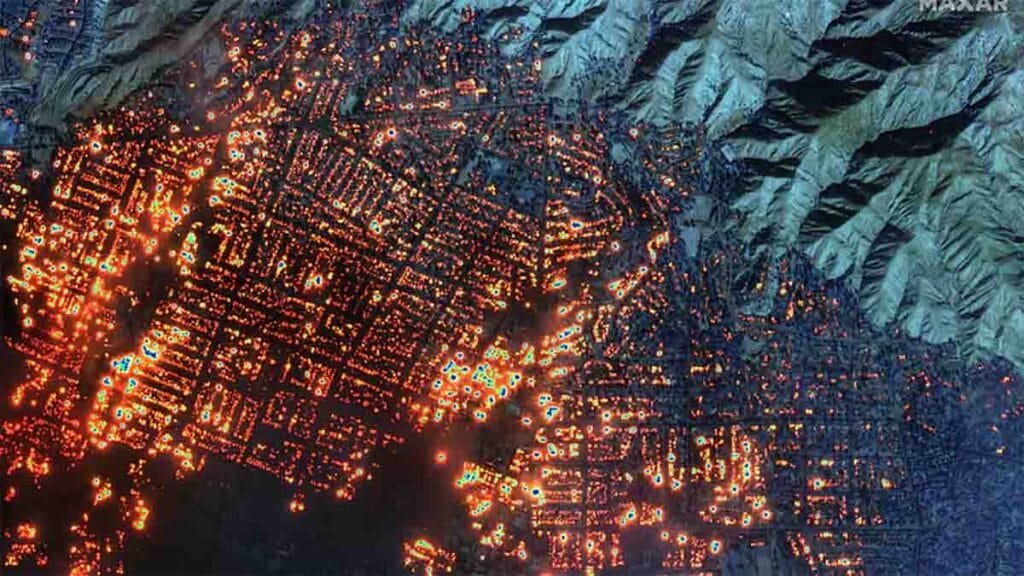- Major blazes in Los Angeles County, including Palisades and Eaton Fires.
- At least 24 lives lost, with more casualties expected.
- Over 12,000 structures destroyed, including homes and landmarks.
- 150,000 residents evacuated amid ongoing containment efforts.
- Dry, windy conditions persist, fueling fire risks.
California is battling one of its most destructive wildfire seasons in recent years. As of January 13, 2025, multiple fires are ravaging the state, predominantly in Los Angeles County, leaving a trail of destruction and tragedy.
The most significant blazes, Palisades Fire and Eaton Fire, continue to burn out of control. Together, these fires have claimed at least 24 lives, destroyed thousands of homes, and displaced tens of thousands of residents.
The Palisades Fire, which originated in Pacific Palisades, has burned 23,713 acres. Despite ongoing containment efforts, only 14% of the fire has been controlled. This fire has destroyed over 5,000 homes and resulted in eight confirmed fatalities.
Burning near Altadena and Pasadena, the Eaton Fire has scorched 14,117 acres and is 33% contained. Tragically, it has claimed 16 lives and caused widespread destruction to homes and infrastructure.
The smaller but still impactful Hurst Fire has burned 799 acres north of San Fernando. While less destructive, it has contributed to the region’s overall crisis.
Human and Structural Toll
The human cost of these wildfires is immense. At least 24 lives have been lost, and rescue teams fear the death toll could rise as they continue to search for missing residents. The devastation has forced over 150,000 individuals to evacuate, leaving behind their homes, possessions, and communities.
The fires have destroyed more than 12,000 structures, including homes, schools, and architectural landmarks. This widespread destruction has significantly impacted the lives of residents and strained local resources. Critical infrastructure, such as power lines and roads, has also been damaged, leading to further disruptions in essential services.
Firefighters are working relentlessly to combat the flames, putting themselves at risk in the process. However, their progress is hindered by strong winds and dry conditions that continue to fuel the fires. These challenging weather conditions make containment efforts particularly difficult and unpredictable.
The Palisades Fire and Eaton Fire remain the primary concerns due to their large scale and proximity to densely populated areas. Officials warn that containment may take several days or even weeks under the current conditions, emphasizing the need for continued vigilance and coordinated efforts.
Weather and Forecast
The wildfire crisis has been exacerbated by severe Santa Ana winds, with gusts reaching speeds of up to 100 mph. These winds have not only fueled the intensity of existing fires but also hindered containment efforts by spreading embers over long distances. The situation is compounded by prolonged drought conditions and extremely low humidity levels, creating an environment ripe for wildfires.
Red-flag warnings are in effect across much of the state, signaling heightened fire danger. Weather forecasts predict that these high winds will persist through midweek, significantly increasing the risk of new ignitions and further complicating firefighting operations. Authorities are urging residents to exercise caution and remain vigilant, as the volatile weather conditions pose a continued threat to lives and property.
Crisis and Resilience
The wildfires have caused significant upheaval across California. Thousands remain without electricity due to power outages, and flight schedules have been severely disrupted. Local events, including the Los Angeles Rams playoff game, have been relocated amid the crisis.
Authorities are actively investigating the causes of the fires. Preliminary reports indicate that remnants of New Year’s Eve fireworks may have sparked the Palisades Fire. Strong winds likely reignited dormant embers, escalating the destruction.
This wildfire crisis highlights the formidable power of nature and the resilience of affected communities. Firefighters and emergency teams are working tirelessly to contain the fires and minimize damage. Residents are urged to follow evacuation orders and stay updated through reliable sources, as the coming days will be pivotal in shaping the outcome of this devastating event.


